
95% of researchers rate our articles as excellent or good
Learn more about the work of our research integrity team to safeguard the quality of each article we publish.
Find out more
ORIGINAL RESEARCH article
Front. Anesthesiol. , 30 November 2022
Sec. Perioperative Medicine
Volume 1 - 2022 | https://doi.org/10.3389/fanes.2022.962280
Objective: Research on acupuncture-related techniques in the perioperative period has been increasing in the last 20 years. In this research, a bibliometric analysis was performed to review the application of acupuncture for perioperative medicine and to evaluate the trends in research on the perioperative use of acupuncture.
Methods: CiteSpace was used to analyze published papers on the perioperative use of acupuncture in the Web of Science database from 2001 to 2021. The research trends were evaluated based on the number of publications, keywords, journals, countries, institutions, and authors. Moreover, collaborative networks and reference co-citation network maps were analyzed.
Results: A total of 719 related studies were included in the analyses. The number of annual publications has gradually been increasing. Evidence-Based Complementary and Alternative Medicine published the most (49 articles). Regarding the cited journals, Anesthesia & Analgesia ranked first in terms of frequency (361), while Pain ranked first in terms of centrality (0.71). China (284) and the China Medical University (26) published the most. Wang Yu (21 articles) was the most active author, while Lee A (116) was the most co-cited author. The most co-cited reference was a meta-analysis of acupuncture for post-operative pain (212). The “post-operative cognitive dysfunction” cluster was new research directions that had recently emerged. Pain-related keywords had the highest frequency in keywords about indications.
Conclusion: Research on perioperative acupuncture is a promising field, and more cooperation in global scientific research is needed. Our results may help researchers in identifying potential collaborators, research frontiers, and hot topics.
There has been growing interest in the use of acupuncture-related techniques in the perioperative period [1, 2]. Perioperative acupuncture can potentially provide various clinically meaningful benefits for patients. It helps reduce the consumption of anesthetics and analgesics and reduce anesthetic and surgical complications, including pain, post-operative nausea and vomiting and hemodynamic episodes [3–7]. Furthermore, perioperative acupuncture may induce organ-protective effects on cardiac and brain function [8, 9]. Acupuncture-related techniques are minimally invasive and inexpensive, and they have attracted the attention of more researchers in perioperative medicine. As a result of increasing demand, it is necessary to examine the relevance of scientific bibliometric research in this field. Furthermore, effectively and adequately identifying scholarly publications is important for establishing the basis for subsequent analyses.
CiteSpace is a science mapping tool designed for conducting a visual analytic study of the literature of a research field, which is known as a knowledge domain [10]. Using CiteSpace, we can construct a series of networks of authors, institutions and countries and clarify the structural patterns and trends of significant developments in a research field. In recent years, the centrality analysis and burst detection functions of CiteSpace have been used to analyze other acupuncture-related fields, including arthritis, pain and imaging [11–13]. High centrality is often well-recognized as a turning point or pivotal point in a field.
Thus, this study analyzes the status, trends, and hotspots of research on perioperative acupuncture using CiteSpace to conduct a comprehensive and systematic bibliometric review of literature obtained from Web of Science (WOS) from 2001 to 2021. From the results, global publication patterns can be established to inform researchers of future research directions and issues.
In this study, the WOS core collection database was adopted as the bibliographic database. The data search strategy included the topic “acupuncture” or “electroacupuncture” or “laser acupuncture” or “acupressure” or “auricular acupuncture” or “transcutaneous electrical acupoint stimulation,” and it also included “pre-operative” or “post-operative” or “anesthesia” or “perioperative,” with the publication period of the literature ranging from January 1st, 2001, to December 31st, 2021. We excluded duplicate publications. There were no restrictions on the type of research. The types of publication were limited to articles and reviews (case reports/series, editorials and letters were excluded). The publishing language was limited to English. The search date was February 4th, 2022.
CiteSpace 5.7.R5 and Excel 2019 were used to analyze the data extracted from WOS. Analysis included descriptive analysis, co-occurrence analysis and co-citation analysis. The annual number of publications, the publishing frequency of journals, countries, institutions, authors, references, and keywords were described. Based on all authors, the co-occurrence map for countries and institutions was drawn. Based on the first author, the frequency and centrality of cited authors were analyzed. The top 20 burst keywords were extracted. We applied a log-likelihood ratio (LLR) algorithm to generate clusters by the keywords of the articles or of the references to explore emerging trends and key information from the cited references. Based on cluster analysis that involved clustering co-citations of articles, a timeline map was drawn to investigate the changes in Research Topics over time. Furthermore, based on the co-citation of keywords, the top ranked keywords of indications for acupuncture-related techniques and of acupuncture techniques were extracted.
The results for the final knowledge map were confirmed by experts in the field of perioperative medicine and acupuncture to verify the strength of the research conclusions in relation to clinical practice.
A total of 729 papers were obtained from WOS. Seven hundred and nineteen papers were obtained after removing duplicates. The number of articles published increased from 5 in 2001 to 88 in 2021, as shown in Figure 1.
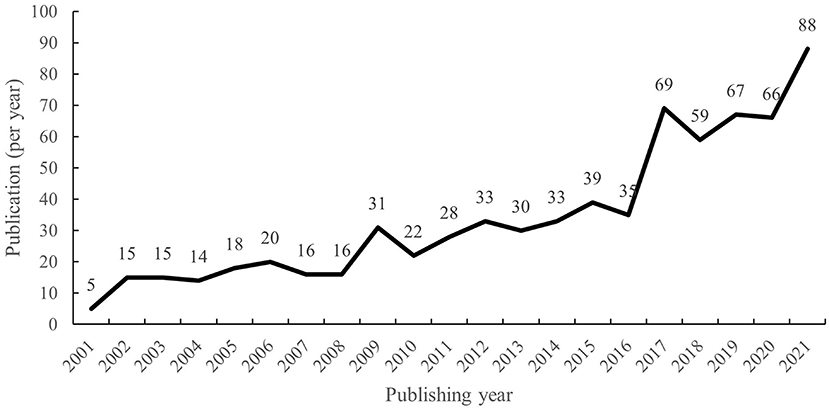
Figure 1. Number of annual publications on perioperative application of acupuncture related techniques from 2001 to 2021.
The number of journals that published the 719 articles on perioperative acupuncture was 616. Evidence-Based Complementary and Alternative Medicine published the most (49 articles). The top 5 most co-cited journals were Anesthesia & Analgesia (361), Anesthesiology, British Journal of Anaesthesia, Acupuncture Medicine and Pain (Table 1). In terms of centrality, the top journal was Pain (0.71) (Table 1). The impact factors of the top 5 journals by frequency were between 2.267 and 9.166. The most cited journal Anesthesia & Analgesia is with an impact factor of 5.178 (year 2020).

Table 1. The top five co-cited journals with the highest frequency or centrality of perioperative application of acupuncture related techniques from 2001 to 2021.
Wang Y (Wang Yu) was the most active author in this research field, with 21 articles, followed by Wang Q (13 articles) and Usichenko Ti (12 articles) (Table 2). Co-authorship and co-citation maps were generated (Figure 2). Author with the most co-authorship was Wang Baoguo (7) (Table 2). The most cited author was Lee A (116), followed by Han JS (110), Wang SM (97), Gan TJ (85) and Lin JG (68). Regarding centrality, the top 5 authors were Chen L, Han JS, Ernst E, Agarwal A and Usichenko Ti (Table 2).

Table 2. Top five active authors, co-occurred, and co-cited authors related to perioperative application of acupuncture related techniques from 2001 to 2021.
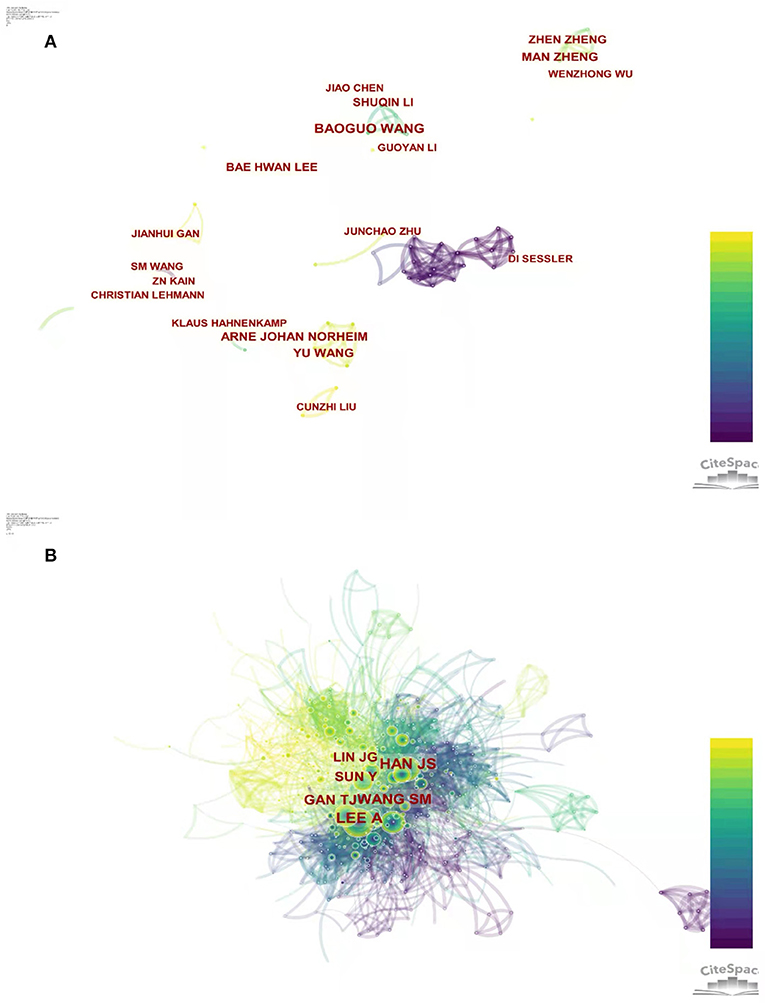
Figure 2. Co-author map (A) and co-citation map (B) related to perioperative application of acupuncture related techniques from 2001 to 2021.
A map of countries co-occurrence was generated. The size of the nodes in the map indicates the number of articles published by a country, and the links (83) between nodes represent the strength and time of the cooperative relationship (Figure 3). The 719 articles were published in 47 countries. The top three countries were the People's Republic of China, the United States (USA) and South Korea. The People's Republic of China accounted for 39.5% (284/719) of the total publications, followed by the United States (158, 22.0%) and South Korea (54, 7.5%). Regarding centrality, the top five countries were the United States (0.81), China (0.32), England (0.29), Germany (0.13), and Switzerland (0.09) (Table 3).
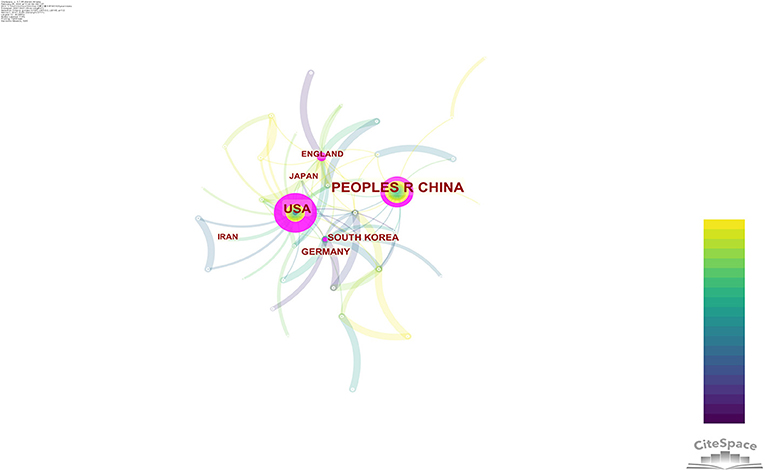
Figure 3. A country cooperation map related to perioperative application of acupuncture related techniques from 2001 to 2021.

Table 3. Top five countries and institutions related to perioperative application of acupuncture related techniques from 2001 to 2021.
An institutional cooperation map was generated. The 719 articles were submitted by 425 institutions. The top five institutions based on the number of publications were the China Medical University (26), Capital Medical University (19), Guangzhou University of Chinese Medicine (17), Kyung Hee University (17), and Beijing University of Chinese Medicine (15) (Table 3 and Figure 4). Regarding centrality, the top 5 institutions were the China Medical University, Capital Medical University, Beijing University of Chinese Medicine, Guangzhou University of Chinese Medicine, and the Chinese Academy of Chinese Medicine and Science.
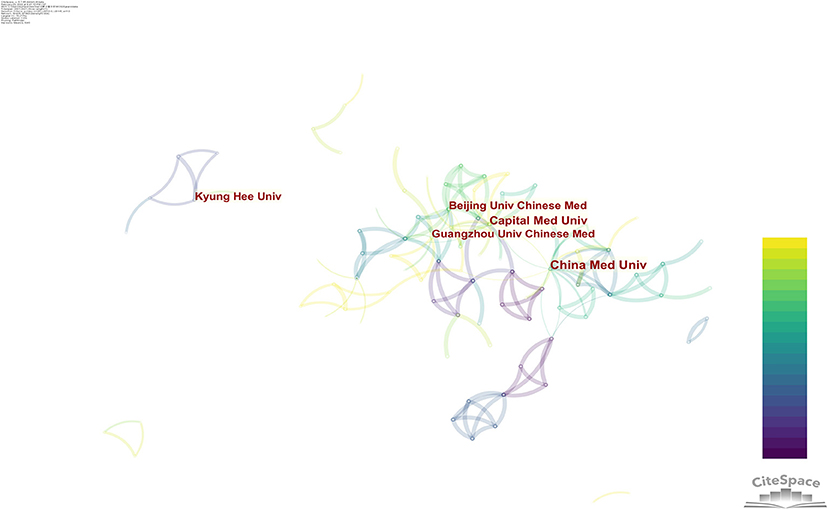
Figure 4. An institution cooperation map related to perioperative application of acupuncture related techniques from 2001 to 2021.
The most frequently cited reference was a meta-analysis on optimal treatment parameters of TENS for post-operative pain [14]. Co-citation implies that two articles were cited in the same article. It suggests that the cited literature and citing literature are related in content, indicating a literature with contents of significant influence. A total of 18,270 references were extracted from the 719 articles to analyze the cited references. We considered 2001 to 2021 as our time span and a time slice of 1. The 50 most frequently cited items that appeared were selected from each time slice to form a network diagram of cited references, with the network consisting of 805 nodes and 2,140 links. The most frequently co-cited reference was a meta-analysis on acupuncture and post-operative pain management (Table 4) [15]. The cited reference with the highest centrality was a randomized clinical trial observing the effect of neuromuscular monitoring over the P6 acupuncture point on the reduction of PONV (Table 4) [16].
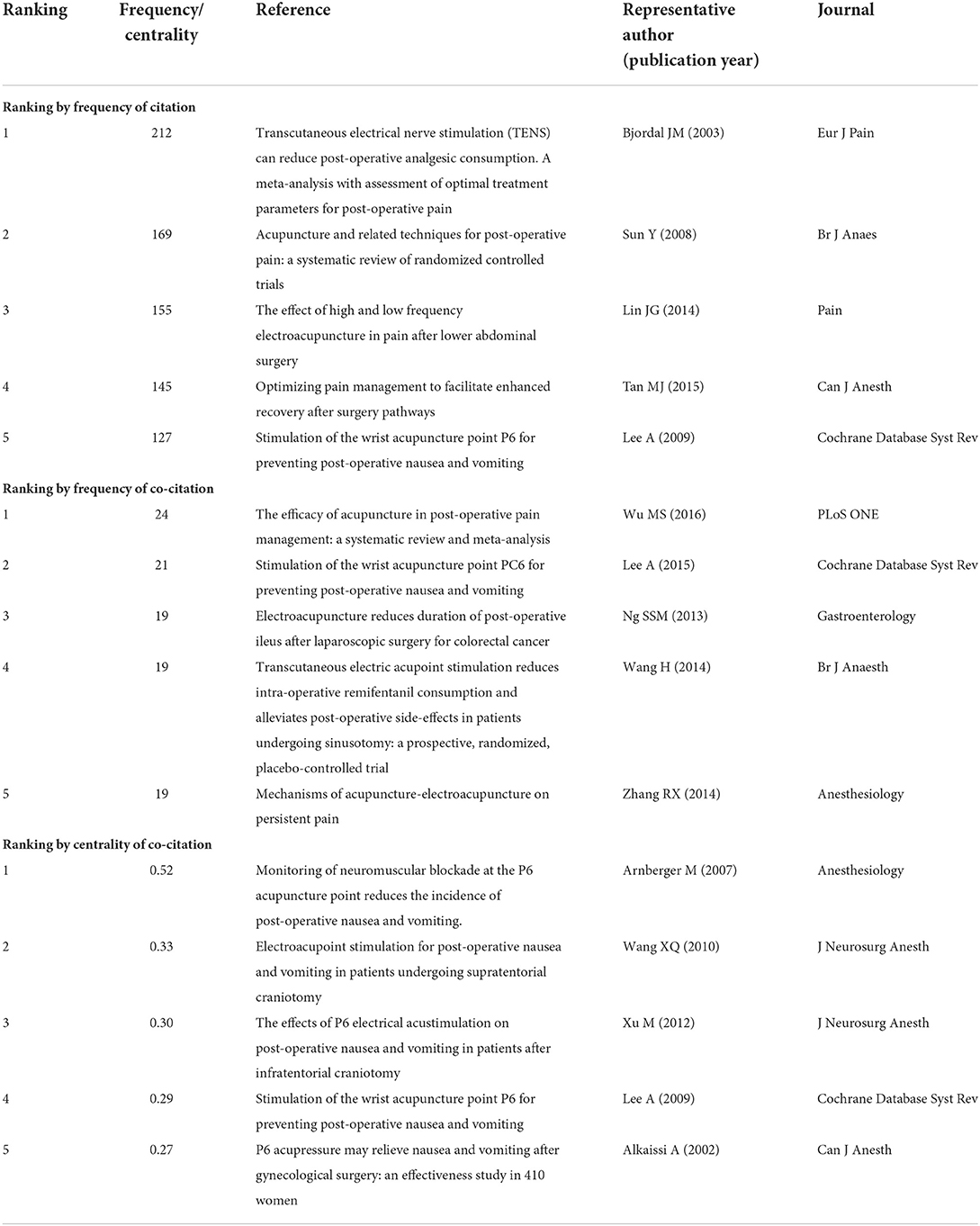
Table 4. The top five cited articles and top five co-cited references for the highest frequency or centrality of perioperative application of acupuncture related techniques from 2001 to 2021.
Twenty-seven clusters were generated from the keywords of the cited references. We list the first 10 clusters with the largest scale. The largest group was “post-operative ileus,” which consisted of 66 reference articles. Clusters #2 “post-operative cognitive dysfunction” was new research direction that had recently emerged (Figure 5).
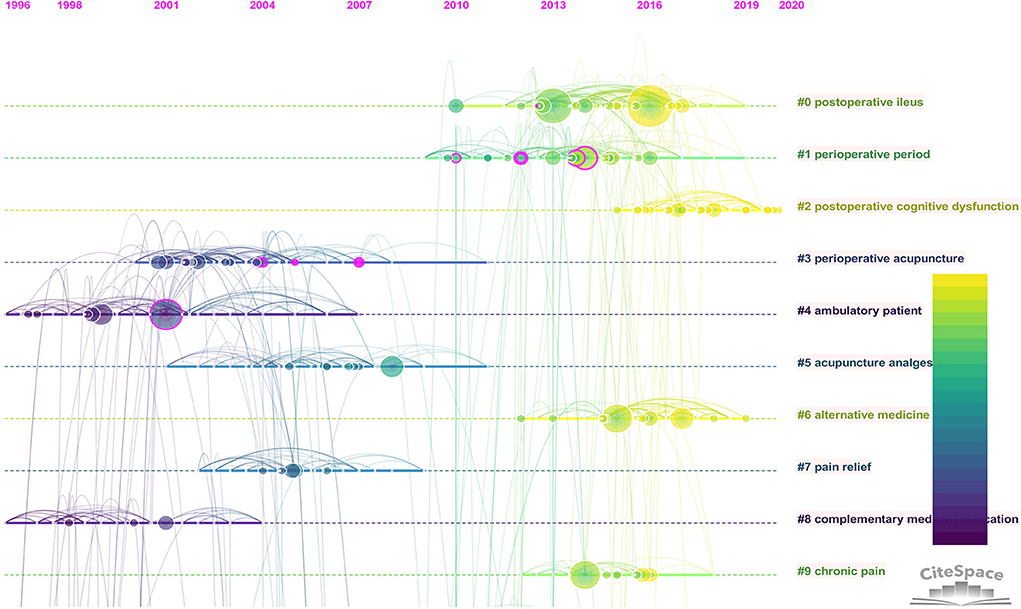
Figure 5. Reference co-citation timeline map related to perioperative application of acupuncture related techniques from 2001 to 2021.
A keyword co-occurrence network containing 544 nodes and 2,218 links was generated. Figure 6 shows a network of co-occurring keywords with high frequencies (the larger the character is, the higher the frequency). The most widely used keywords related to perioperative acupuncture over the last 20 years were “acupuncture,” “electroacupuncture” and “pain.” We also extracted high-frequency keywords related to indications of acupuncture or acupuncture techniques. Pain was the indication with the highest frequency (136). Acupuncture was the technique with the highest frequency (335). Using LLR algorithm, eight clusters were generated (Figure 7). The largest group was “post-operative ileus,” which consisted of 91 keywords.
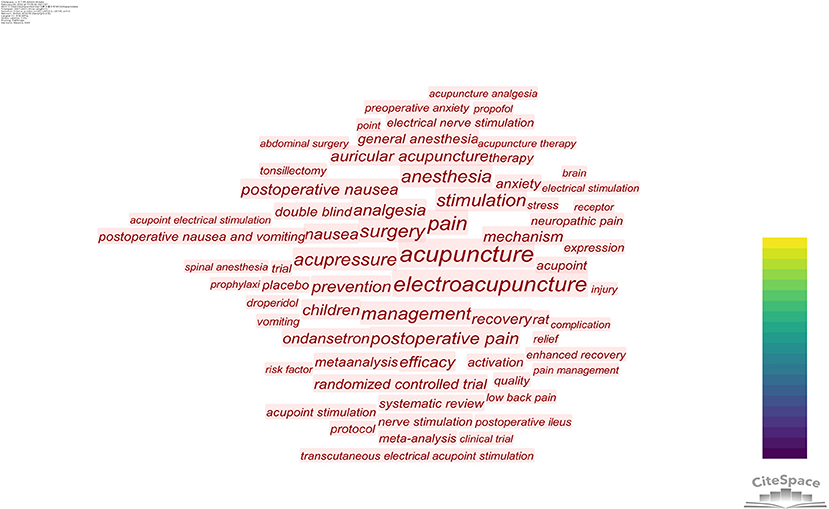
Figure 6. Keyword co-occurrence map related to perioperative application of acupuncture related techniques from 2001 to 2021.
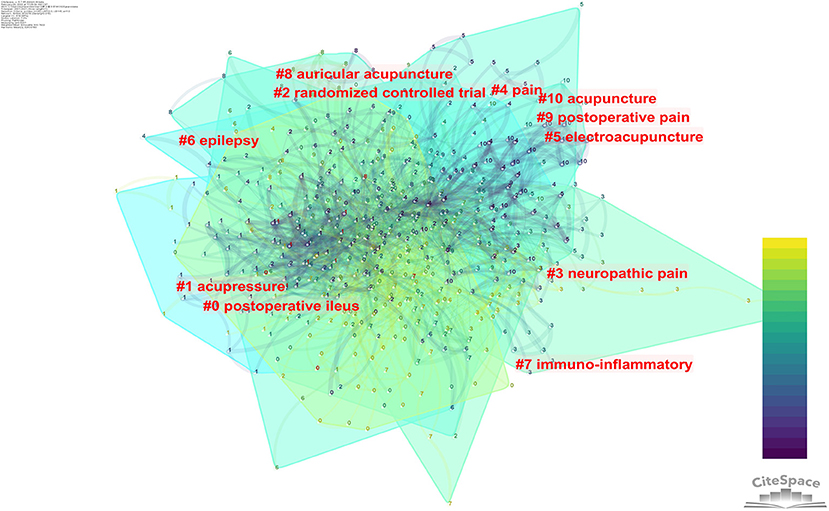
Figure 7. Clusters of keyword co-occurrence map related to perioperative application of acupuncture related techniques from 2001 to 2021.
Burst keywords were generated to record keywords that changed greatly within a short period of time. Such keywords are thought to be related to research hotspots or future trends. The top 20 keywords with the strongest citation bursts are presented in Figure 8. “Stimulation” was the keyword with the strongest citation burst, and it was identified as a frontier research item in the 2007–2013 period. “Systemic review,” “meta-analysis,” and “protocol” were burst keywords between 2019 and 2021.
To the best of our knowledge, this paper is the first bibliometric study on the application of acupuncture in perioperative medicine. By retrieving data from 719 studies published between 2001 and 2021 and conducting co-occurrence and co-citation analyses using CiteSpace, we outlined the research trends and cooperation status of research on perioperative acupuncture over the last 20 years and highlighted potential hot spots for future studies.
We found a general increasing trend in research on perioperative acupuncture during the last 20 years. This trend was consistent with that observed in other fields of research on acupuncture, including acupuncture analgesia [11, 17–19]. According to the current trend analysis, research on perioperative acupuncture will continue to show an overall growth trend in the next few years.
According to the frequency analysis, researchers in Asia have conducted the most studies in the field of perioperative acupuncture, but the most significant finding was found by researchers in the USA. And the cooperation among countries and institutions was weak compared with research of other fields. The linkage among countries reported in depressive disorder was 75 countries with 600 links [20], while the linkage in perioperative acupuncture was 47 countries with 84 links. Cooperation should be paid attention to in the future.
Acupuncture analgesia is one of the earliest research points in the field of acupuncture. Han [21–23], who has been engaged in research on acupuncture analgesia, was among the top 5 most cited authors. This result is in accordance with the dominant position of acupuncture analgesia in the field of perioperative acupuncture. A Systematic Review and Meta-Analysis on the Efficacy of Acupuncture in Post-Operative Pain Management is the top co-cited reference by frequency (24 times). This study updates the evidence that certain modes of acupuncture improve post-operative pain on the first day after surgery and reduce opioid use [15]. And the most frequently cited reference was a meta-analysis on optimal treatment parameters of TENS for post-operative pain [14]. These findings indicate that pain remains a research field of significant influence. The most cited author, Lee A, is from Chinese University of Hong Kong, Prince pf Wales Hospital. His articles provided meta-analysis and Cochrane reviews of acupuncture alleviating post-operative nausea and vomiting [24–27]. Combined with the result of co-cited reference analysis that the top 5 reference by centrality were papers providing evidence for P6 acupuncture treatment of PONV [16, 27–30], it is indicated that PONV has been a hot spot in the field of perioperative acupuncture. The effects of analgesia and preventing PONV have been validated in various populations and the underlying mechanisms remains to be elucidate.
Our results suggested that publishing in higher-impact journals is challenging for researches in the field of perioperative acupuncture. Articles about acupuncture published in top journals including science, lancet and JAMA are not rare. Thus, high-quality studies following the STandards for Reporting Interventions in Clinical Trials of Acupuncture (STRICTA) [31–34] and the extension of CONSORT for reporting interventions in clinical trials of acupuncture are needed.
All the top 3 most cited journals are JCR1-level journals in the field of anesthesia (Anesth Analg, Anesthesiology, Brit J Anaesth), reflecting the great involvement of anesthesiologists in research on perioperative acupuncture. Anesthesiologists should explore acupuncture in a broader perspective. Cluster analysis showed that “post-operative cognitive dysfunction” has been research hotspots for researchers in recent years. Post-operative brain function has attracted great attentions. For example, there has been researches on post-operative delirium [35], post-operative cognitive dysfunction [36, 37] and the sleep mode [38]. The keyword analysis results provide hints for research frontiers. Consistent with other bibliometric studies on acupuncture, “pain” is the most common disorder that perioperative acupuncture is used for. “Randomized controlled trial” was an important research method.
In addition, a burst keyword can indicate cutting-edge Research Topics and reveal studies that have potential or are of interest. The history of research on perioperative acupuncture can be drawn from the evolution of the keywords used in these articles. For example, “ondansetron,” “non-pharmacological intervention” and “children” were the earliest words to have an impact. However, since 2019, with accumulated evidence in the field of perioperative acupuncture, systemic reviews and meta-analysis are increasing. And more people are getting aware of the importance of publishing “protocol.”
Our study has some limitations. In this study, we performed co-occurrence and cluster analyses based on data retrieved from WOS because it provides references that were compiled based on the requirements of CiteSpace software for formatting the references used for co-citation analysis. It includes SCI-Expanded, SSCI, A&HCI, and ESCI. And we limited the publishing language to English. Further analysis of other databases, including the CNKI and CSSI databases, and of articles published in other languages is needed.
In conclusion, Research on the perioperative use of acupuncture-related techniques is a promising field. However, more cooperation in global scientific research is needed. Additionally, researchers need to optimize their study design to publish more high-quality articles in high-impact journals. Pain has been a hot spot of research in the field of perioperative acupuncture, but the frontier issues have changed to post-operative cognitive dysfunction. Our results may help researchers in identifying potential collaborators, research frontiers, and hot topics.
The original contributions presented in the study are included in the article/supplementary material, further inquiries can be directed to the corresponding author/s.
MZ, ZC, and JZ collected and analyzed the data. ZL made substantial contributions to the design of the work and critically revised the manuscript. YW helped in analyzing and interpreting the data. MZ and ZL finished the draft. All authors approved the final version of the manuscript accepted for publication.
This research was funded by the National Nature and Science Foundation of China (81871028), Improving Project of Fourth Military Medical University (2016TSB-014), Accelerate Project of Xijing Hospital (XJZT19ML11), and Incubation Program of Chinese Traditional Medicine (2021ZY019).
The authors declare that the research was conducted in the absence of any commercial or financial relationships that could be construed as a potential conflict of interest.
All claims expressed in this article are solely those of the authors and do not necessarily represent those of their affiliated organizations, or those of the publisher, the editors and the reviewers. Any product that may be evaluated in this article, or claim that may be made by its manufacturer, is not guaranteed or endorsed by the publisher.
WOS, web of science; Anesth Analg, Anesthesia & Analgesia; Brit J Anaesth, British Journal of Anaesthesia; Acupunct Med, Acupuncture Medicine; Evid-Based Compl Alt, Evidence-Based Complementary and Alternative Medicine; Neurosci Lett, Neuroscience Letter; PONV, post-operative nausea and vomiting; POCD, post-operative cognitive dysfunction; LLR, log-likelihood ratio; STRICTA, STandards for Reporting Interventions in Clinical Trials of Acupuncture; CONSORT, Consolidated Standards of Reporting Trials.
1. Lu Z, Dong H, Wang Q, Xiong L. Perioperative acupuncture modulation: more than anaesthesia. Br J Anaesth. (2015) 115:183–93. doi: 10.1093/bja/aev227
2. Lu Z, Wang Q, Sun X, Zhang W, Min S, Zhang J, et al. Transcutaneous electrical acupoint stimulation before surgery reduces chronic pain after mastectomy: a randomized clinical trial. J Clin Anesth. (2021) 74:110453. doi: 10.1016/j.jclinane.2021.110453
3. Alizadeh R, Esmaeili S, Shoar S, Bagheri-Hariri S, Shoar N. Acupuncture in preventing postoperative nausea and vomiting: efficacy of two acupuncture points versus a single one. J Acupunct Meridian Stud. (2014) 7:71–5. doi: 10.1016/j.jams.2013.04.005
4. El-Deeb AM, Ahmady MS. Effect of acupuncture on nausea and/or vomiting during and after cesarean section in comparison with ondansetron. J Anesth. (2011) 25:698–703. doi: 10.1007/s00540-011-1198-0
5. LIN YC, Tassone RF, Jahng S, Rahbar R, Holzman RS, Zurakowski D, et al. Acupuncture management of pain and emergence agitation in children after bilateral myringotomy and tympanostomy tube insertion. Paediatr Anaesth. (2009) 19:1096–101. doi: 10.1111/j.1460-9592.2009.03129.x
6. Liodden I, Norheim AJ. Acupuncture and related techniques in ambulatory anesthesia. Curr Opin Anaesthesiol. (2013) 26:661–8. doi: 10.1097/ACO.0000000000000017
7. Liu X, Li S, Wang B, An L, Ren X, Wu H. Intraoperative and postoperative anaesthetic and analgesic effect of multipoint transcutaneous electrical acupuncture stimulation combined with sufentanil anaesthesia in patients undergoing supratentorial craniotomy. Acupunct Med. (2015) 33:270–6. doi: 10.1136/acupmed-2014-010749
8. Chen GB. Acupuncture anesthesia in neurosurgery. Am J Chin Med. (1980) 8:271–82. doi: 10.1142/S0192415X80000244
9. Zhou J, Chi H, Cheng TO, Chen TY, Wu YY, Zhou WX, et al. Acupuncture anesthesia for open heart surgery in contemporary China. Int J Cardiol. (2011) 150:12–6. doi: 10.1016/j.ijcard.2011.04.002
10. Chen C. CiteSpace II: detecting and visualizing emerging trends and transient patterns in scientific literature. J Am Soc Inform Sci Technol. (2006) 57:359–77. doi: 10.1002/asi.20317
11. Gao Z, Zhang J, Liu GF, Ji LX. Research trends from 2010 to 2020 for pain treatment with acupuncture: a bibliometric analysis. J Pain Res. (2021) 14:941–52. doi: 10.2147/JPR.S300911
12. Li R, Sun J, Hu H, Zhang Q, Sun R, Zhou S, et al. Research trends of acupuncture therapy on knee osteoarthritis from 2010 to 2019: a bibliometric analysis. J Pain Res. (2020) 13:1901–13. doi: 10.2147/JPR.S258739
13. Liang YD, Li Y, Zhao J, Wang XY, Zhu HZ, Chen XH. Study of acupuncture for low back pain in recent 20 years: a bibliometric analysis via CiteSpace. J Pain Res. (2017) 10:951–64. doi: 10.2147/JPR.S132808
14. Bjordal JM, Johnson MI, Ljunggreen AE. Transcutaneous electrical nerve stimulation (TENS) can reduce postoperative analgesic consumption. A meta-analysis with assessment of optimal treatment parameters for postoperative pain. Eur J Pain. (2003) 7:181–8. doi: 10.1016/S1090-3801(02)00098-8
15. Wu MS, Chen KH, Chen IF, Huang SK, Tzeng PC, Yeh ML, et al. The efficacy of acupuncture in post-operative pain management: a systematic review and meta-analysis. PLoS ONE. (2016) 11:e0150367. doi: 10.1371/journal.pone.0150367
16. Arnberger M, Stadelmann K, Alischer P, Ponert R, Melber A, Greif R. Monitoring of neuromuscular blockade at the P6 acupuncture point reduces the incidence of postoperative nausea and vomiting. Anesthesiology. (2007) 107:903–8. doi: 10.1097/01.anes.0000290617.98058.d9
17. Vickers AJ, Cronin AM, Maschino AC, Lewith G, MacPherson H, Foster NE, et al. Acupuncture for chronic pain: individual patient data meta-analysis. Arch Intern Med. (2012) 172:1444–53. doi: 10.1001/archinternmed.2012.3654
18. Huang L, Xu G, He J, Tian H, Zhou Z, Huang F, et al. Bibliometric analysis of functional magnetic resonance imaging studies on acupuncture analgesia over the past 20 years. J Pain Res. (2021) 14:3773–89. doi: 10.2147/JPR.S340961
19. Pan H, Xi Z, Yu X, Sun X, Wei X, Wang K. Knowledge mapping analysis of international research on acupuncture for low back pain using bibliometrics. J Pain Res. (2021) 14:3733–46. doi: 10.2147/JPR.S340992
20. Xu D, Wang YL, Wang KT, Wang Y, Dong XR, Tang J, et al. A scientometrics analysis and visualization of depressive disorder. Curr Neuropharmacol. (2021) 19:766–86. doi: 10.2174/1570159X18666200905151333
21. Han JS. Acupuncture analgesia: areas of consensus and controversy. Pain. (2011) 152:S41–8. doi: 10.1016/j.pain.2010.10.012
22. Han JS, Ho YS. Global trends and performances of acupuncture research. Neurosci Biobehav Rev. (2011) 35:680–7. doi: 10.1016/j.neubiorev.2010.08.006
23. Han SP, Han JS. Acupuncture and related techniques for pain relief and treatment of heroin addiction: mechanisms and clinical application. Med Acupunct. (2020) 32:403–4. doi: 10.1089/acu.2020.1485
24. Lee A, Chan S. Acupuncture and anaesthesia. Best Pract Res Clin Anaesthesiol. (2006) 20:303–314. doi: 10.1016/j.bpa.2005.10.009
25. Lee A, Chan SK, Fan LT. Stimulation of the wrist acupuncture point PC6 for preventing postoperative nausea and vomiting. Cochrane Database Syst Rev. (2015) 2015:Cd003281. doi: 10.1002/14651858.CD003281.pub4
26. Lee A, Done ML. Stimulation of the wrist acupuncture point P6 for preventing postoperative nausea and vomiting. Cochrane Database Syst Rev. (2004) 2004:Cd003281. doi: 10.1002/14651858.CD003281.pub2
27. Lee A, Fan LT. Stimulation of the wrist acupuncture point P6 for preventing postoperative nausea and vomiting. Cochrane Database Syst Rev. (2009) 2009:Cd003281. doi: 10.1002/14651858.CD003281.pub3
28. Alkaissi A, Evertsson K, Johnsson VA, Ofenbartl L, Kalman S. P6 acupressure may relieve nausea and vomiting after gynecological surgery: an effectiveness study in 410 women. Can J Anaesth. (2002) 49:1034–9. doi: 10.1007/BF03017897
29. Wang XQ, Yu JL, Du ZY, Xu R, Jiang CC, Gao X. Electroacupoint stimulation for postoperative nausea and vomiting in patients undergoing supratentorial craniotomy. J Neurosurg Anesthesiol. (2010) 22:128–31. doi: 10.1097/ANA.0b013e3181c9fbde
30. Xu M, Zhou SJ, Jiang CC, Wu Y, Shi WL, Gu HH, et al. The effects of P6 electrical acustimulation on postoperative nausea and vomiting in patients after infratentorial craniotomy. J Neurosurg Anesthesiol. (2012) 24:312–6. doi: 10.1097/ANA.0b013e31825eb5ef
31. Liu L, Skinner M, McDonough SM, Kannan P, Baxter GD. STRICTA: is it time to do more? BMC Complement Altern Med. (2015) 15:190. doi: 10.1186/s12906-015-0714-4
32. Ma B, Chen ZM, Xu JK, Wang YN, Chen KY, Ke FY, et al. Do the CONSORT and STRICTA checklists improve the reporting quality of acupuncture and moxibustion randomized controlled trials published in Chinese journals? A systematic review and analysis of trends. PLoS ONE. (2016) 11:e0147244. doi: 10.1371/journal.pone.0147244
33. MacPherson H, Altman DG, Hammerschlag R, Youping L, Taixiang W, White A, et al. Revised STandards for Reporting Interventions in Clinical Trials of Acupuncture (STRICTA): extending the CONSORT statement. Acupunct Med. (2010) 28:83–93. doi: 10.1136/aim.2009.001370
34. MacPherson H White A Cummings M Jobst K Rose K Niemtzow Niemtzow R Standards for reporting interventions in controlled trials of acupuncture: the STRICTA recommendations. STandards for Reporting Interventions in controlled trails of acupuncture. Acupunct Med. (2002) 20:22–5. doi: 10.1136/aim.20.1.22
35. Levy I, Gavrieli S, Hefer T, Attias S, Schiff A, Oliven R, et al. Acupuncture treatment of delirium in older adults hospitalized in internal medicine departments: an open-label pragmatic randomized-controlled trial. J Geriatr Psychiatry Neurol. 2021:891988721996804. doi: 10.1177/0891988721996804
36. Tang Y, Wang T, Yang L, Zou X, Zhou J, Wu J, et al. Acupuncture for post-operative cognitive dysfunction: a systematic review and meta-analysis of randomized controlled trials. Acupunct Med. (2021) 39:423–31. doi: 10.1177/0964528420961393
37. Liu T, Yin C, Li Y, Gao F, Yu L, Wang Z, et al. Effects of transcutaneous electrical acupoint stimulation on postoperative cognitive decline in elderly patients: a pilot study. Clin Interv Aging. (2021) 16:757–65. doi: 10.2147/CIA.S309082
Keywords: acupuncture, perioperative medicine, CiteSpace, bibliometric analysis, hotspot
Citation: Zhang M, Cairen Z, Zhang J, Wang Y and Lu Z (2022) Trends in research on the perioperative use of acupuncture in the last 20 years: A CiteSpace-based bibliometric analysis and literature review. Front. Anesthesiol. 1:962280. doi: 10.3389/fanes.2022.962280
Received: 06 June 2022; Accepted: 21 July 2022;
Published: 30 November 2022.
Edited by:
Ali Dabbagh, Shahid Beheshti University of Medical Sciences, IranReviewed by:
Abhijit Nair, Ministry of Health, OmanCopyright © 2022 Zhang, Cairen, Zhang, Wang and Lu. This is an open-access article distributed under the terms of the Creative Commons Attribution License (CC BY). The use, distribution or reproduction in other forums is permitted, provided the original author(s) and the copyright owner(s) are credited and that the original publication in this journal is cited, in accordance with accepted academic practice. No use, distribution or reproduction is permitted which does not comply with these terms.
*Correspondence: Zhihong Lu, ZGVlcmx1MjNAMTYzLmNvbQ==
†These authors have contributed equally to this work
Disclaimer: All claims expressed in this article are solely those of the authors and do not necessarily represent those of their affiliated organizations, or those of the publisher, the editors and the reviewers. Any product that may be evaluated in this article or claim that may be made by its manufacturer is not guaranteed or endorsed by the publisher.
Research integrity at Frontiers

Learn more about the work of our research integrity team to safeguard the quality of each article we publish.